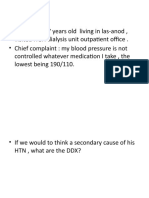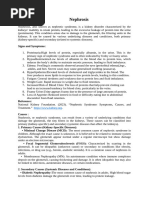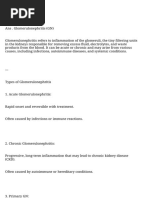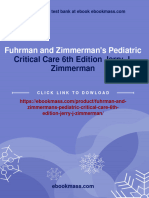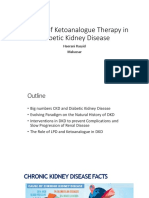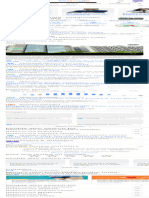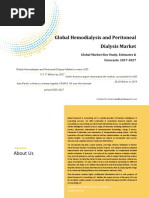Glomerulonephritis
Glomerulonephritis
Uploaded by
maleskunCopyright:
Available Formats
Glomerulonephritis
Glomerulonephritis
Uploaded by
maleskunOriginal Title
Copyright
Available Formats
Share this document
Did you find this document useful?
Is this content inappropriate?
Copyright:
Available Formats
Glomerulonephritis
Glomerulonephritis
Uploaded by
maleskunCopyright:
Available Formats
SJS July-03
GLOMERULONEPHRITIS FOR DUMMIES
Madaio MP, Harrington JT. The diagnosis of glomerular diseases. Arch Intern Med. 2001 Jan 8;161(1):25-34.
Hricik DE, Chung-Park M, Sedor JR. Glomerulonephritis. N Engl J Med. 1998 Sep 24;339(13):888-99.
Take home points:
1. Don’t freak out when you have a patient with possible glomerulonephritis – the differential diagnosis can
be straightforward if you use a systematic approach.
2. The ddx of intrinsic renal disease is: glomerular, tubular, interstitial, or vascular
3. Glomerulonephritis presents with an active sediment (RBC, protein) and nephrotic syndrome presents
with a bland sediment (heavy protein, otherwise negative U/A).
4. The serum complements is the next step in diagnosing the cause of glomerulonephritis.
Step 1: Determine the broad cause of the acute or progressive renal failure
• Pre-renal, intrinsic renal, or post-renal
• FENa (if oliguric – to differentiate pre-renal from ATN), U/A (to look for an active sidement),
and renal ultrasound (to rule out obstruction) can be helpful
• If intrinsic renal, then your differential diagnosis is:
− Glomeruli (e.g. glomerulonephritis or nephrotic syndrome or both)
− Tubules (e.g. ATN)
− Interstitium (e.g. acute interstitial nephritis (AIN))
− Vessels (e.g. atheroembolic renal disease, PAN)
Step 2: If you’ve determined it’s a glomerular cause of renal failure, differentiate a glomerulonephritis (GN) pattern from a
nephrotic syndrome pattern
• At this step, you must get a urinalysis, renal ultrasound, 24 hour urine protein and creatinine,
spot urine protein and creatinine (for protein:creatinine ratio)
• Glomerulonephritis – look for active sediment (U/A with protein and RBCs, dysmorphic RBCs,
and/or RBC casts), 300 mg - 3.5 g/day proteinuria, HTN, edema
• Nephrotic syndrome – look for anasarca, heavy proteinuria (more than 3.5 g/day), and a bland
sediment on U/A (no RBCs). Patients with true nephrotic syndrome (and not just heavy
proteinuria) will have hyperlipidemia, lipiduria, hypoalbuminemia and a hypercoagulable state
(seen most often in membranous nephropathy).
• Membranoproliferative glomerulonephritis (MPGN) can present as nephrotic syndrome,
glomerulonephritis or both.
Step 3: Use the serum complement levels to look help differentiate causes of GN.
• Normal serum complement levels indicate that the production of complement is keeping up with
consumption (normal complements doesn’t mean that complement is not involved in the
underlying disease process).
• Once you have the complement levels back, differentiate the GN further by looking for systemic
diseases vs. isolated renal diseases.
Low complement GN:
• Systemic: SLE, endocarditis, cryoglobulinemia, shunt nephritis
• Isolated renal: post-infectious GN, MPGN
Normal complement GN:
• Systemic: HSP, ANCA-associted (Wegener’s, PAN), Goodpasture’s syndrome, hypersensitivity vasculitis
• Isolated renal: IgA nephropathy, anti-GBM disease, RPGN
You might also like
- Renal Physiology For The Clinician Full Series CJASN PDFDocument230 pagesRenal Physiology For The Clinician Full Series CJASN PDFmms100% (3)
- Nephrology MnemonicsDocument5 pagesNephrology MnemonicsAnnapurna DangetiNo ratings yet
- Nephrology - Proteinuria - SOAP Note - Manish Suneja PDFDocument4 pagesNephrology - Proteinuria - SOAP Note - Manish Suneja PDFΝίκος ΣυρίγοςNo ratings yet
- Naplex Complete Study Outline A Topic-Wise Approach DiabetesFrom EverandNaplex Complete Study Outline A Topic-Wise Approach DiabetesRating: 4 out of 5 stars4/5 (3)
- Table of Content: Post-Streptococcal Glomerulonephritis 3Document5 pagesTable of Content: Post-Streptococcal Glomerulonephritis 3rup100% (1)
- Nephritic - Nephrotic SyndromesDocument4 pagesNephritic - Nephrotic SyndromesjoeNo ratings yet
- Approach Nefroritic SXDocument58 pagesApproach Nefroritic SX[ qιlα ]No ratings yet
- Protein Uri ADocument11 pagesProtein Uri AAli AshrafNo ratings yet
- Nephritic & NephroticDocument18 pagesNephritic & Nephroticlolla2009No ratings yet
- Nepro GNDocument6 pagesNepro GNHajime NakaegawaNo ratings yet
- Glomerular Disorders - Part I & Part II (ARI NOTES)Document144 pagesGlomerular Disorders - Part I & Part II (ARI NOTES)Laiba FatimaNo ratings yet
- HematuriaDocument37 pagesHematuriaعبدالحكيم عمر عامر بن الزوعNo ratings yet
- Approach To The Patient With Renal Disease: Dr. Silvia SpânuDocument25 pagesApproach To The Patient With Renal Disease: Dr. Silvia SpânuSergiuNo ratings yet
- Glo Me Rulo NefritisDocument58 pagesGlo Me Rulo NefritisFany SholehaNo ratings yet
- t2 Kidney DiseaseDocument52 pagest2 Kidney Diseasewany.fyza54No ratings yet
- Nephrotic Syndrome: DR Putra Hendra SPPD UnibaDocument46 pagesNephrotic Syndrome: DR Putra Hendra SPPD UnibafifahNo ratings yet
- экзамен здоровье взрослыхDocument93 pagesэкзамен здоровье взрослыхdrsunil278No ratings yet
- Glomerulopatías PrimariasDocument8 pagesGlomerulopatías PrimariasGSENo ratings yet
- (Study Group) Diabetic Nephropathy, Hypertensive NephropathyDocument7 pages(Study Group) Diabetic Nephropathy, Hypertensive NephropathyZarif IzzuddinNo ratings yet
- Nephrotic SyndromDocument6 pagesNephrotic SyndromRowshon AraNo ratings yet
- RENAL VASCULAR DISEASES UpdatedDocument97 pagesRENAL VASCULAR DISEASES UpdatedgibreilNo ratings yet
- Nephrotic SyndromeDocument18 pagesNephrotic SyndromeHah LaNo ratings yet
- Wa0011.Document180 pagesWa0011.Mohamed AbdelmoniemNo ratings yet
- 1-2 - Заболевания АНГЛDocument6 pages1-2 - Заболевания АНГЛsharkNo ratings yet
- Pathology of Common Glomerular Syndromes: DR Purushotham KrishnappaDocument34 pagesPathology of Common Glomerular Syndromes: DR Purushotham KrishnappaTarin IslamNo ratings yet
- 22 - Proteinuria and HematuriaDocument73 pages22 - Proteinuria and HematuriaArsalan NadeemNo ratings yet
- NephrosisDocument5 pagesNephrosisKalpavalliNo ratings yet
- Overview of Heavy Proteinuria and The: Nephrotic SyndromeDocument31 pagesOverview of Heavy Proteinuria and The: Nephrotic SyndromegibreilNo ratings yet
- CHAPTER 1 History and Physical Diagnosis - 2012 - Nephrology Secrets Third EditionDocument5 pagesCHAPTER 1 History and Physical Diagnosis - 2012 - Nephrology Secrets Third EditionDenisse Tinajero SánchezNo ratings yet
- CKD UnsoedDocument42 pagesCKD UnsoedSutan Malik IbrahimNo ratings yet
- Approach To ProteinuriaDocument2 pagesApproach To ProteinuriaCassandra TingNo ratings yet
- CME UGIB, Hypovolemic Shock 31.12.21 - FINALDocument58 pagesCME UGIB, Hypovolemic Shock 31.12.21 - FINALThayalan RaviNo ratings yet
- Gga Anak PDFDocument27 pagesGga Anak PDFAlexandro HomalessyNo ratings yet
- Acute Kidney InjuryDocument62 pagesAcute Kidney InjuryIvan HensonNo ratings yet
- Nephrotic Syndrome: BasicsDocument5 pagesNephrotic Syndrome: BasicspipitacisNo ratings yet
- Diabetic NephropathyDocument5 pagesDiabetic NephropathydnllkzaNo ratings yet
- Nephrotic Sydnrome 1Document50 pagesNephrotic Sydnrome 1Noor un nisaNo ratings yet
- Sindroma Nefrotik Vs NefritikDocument23 pagesSindroma Nefrotik Vs NefritikihsanNo ratings yet
- Study of Urinary N-Acetyl-Beta-D-Glucosaminidase As A Biomarker ofDocument6 pagesStudy of Urinary N-Acetyl-Beta-D-Glucosaminidase As A Biomarker ofdrosabryNo ratings yet
- Clinical Presentation of Glomerular and Tubuloinsterstitial DiseasesDocument32 pagesClinical Presentation of Glomerular and Tubuloinsterstitial DiseasesgshasantopalNo ratings yet
- Anesthesia For Kidney DiseaseDocument6 pagesAnesthesia For Kidney DiseaseFrits Dede SinagaNo ratings yet
- lupus nephritisDocument28 pageslupus nephritismuhammad omerNo ratings yet
- F Kuliah-Nephritic Syndrome-FK UiSUDocument40 pagesF Kuliah-Nephritic Syndrome-FK UiSUandreNo ratings yet
- Diagnostic Approach To Chronic Kidney DiseaseDocument3 pagesDiagnostic Approach To Chronic Kidney DiseaseBlomblom Pow00No ratings yet
- Sindroma Nefrotik Vs NefritikDocument23 pagesSindroma Nefrotik Vs NefritikUswatun Aortatika KhasanahNo ratings yet
- Renal and Urinary DisordersDocument11 pagesRenal and Urinary DisordersChristian Espanilla100% (4)
- Clinical Presentation & Management of Glomerular Diseases: Hematuria, Nephritic & Nephrotic SyndromeDocument4 pagesClinical Presentation & Management of Glomerular Diseases: Hematuria, Nephritic & Nephrotic SyndromeMutiara FauzaNo ratings yet
- Glomerular DiseasesDocument5 pagesGlomerular DiseasesAdrian ZapataNo ratings yet
- 3&4 Glomerular Diseases and Nephrotic SyndromeDocument46 pages3&4 Glomerular Diseases and Nephrotic SyndromeTor Koang ThorNo ratings yet
- Primary Care Approach To Proteinuria: Amir Said Alizadeh Naderi, MD, and Robert F. Reilly, MDDocument6 pagesPrimary Care Approach To Proteinuria: Amir Said Alizadeh Naderi, MD, and Robert F. Reilly, MDraviibtNo ratings yet
- GlomerulonephritisDocument4 pagesGlomerulonephritisEmilene ZaragozaNo ratings yet
- Nephrotic Syndrome in ChildrenDocument33 pagesNephrotic Syndrome in ChildrenAlvin Omondi100% (1)
- Approach: A. How The Kidney Handle The Proteins?Document9 pagesApproach: A. How The Kidney Handle The Proteins?Rashed ShatnawiNo ratings yet
- Chapter 3 PathologyDocument95 pagesChapter 3 PathologyIflaq ShowkatNo ratings yet
- GlomerulonephritisDocument58 pagesGlomerulonephritisJosa Anggi Pratama0% (1)
- Kidney DiseasesDocument22 pagesKidney Diseasesphoto copyhemnNo ratings yet
- Acute GlomerulonephritisDocument18 pagesAcute GlomerulonephritisdanielaNo ratings yet
- Paediatric Glomerolonephritis and NephroticDocument11 pagesPaediatric Glomerolonephritis and NephroticTiong NeeNo ratings yet
- Sindrom NefrotikDocument22 pagesSindrom NefrotikGyta Apriati100% (1)
- Diabetes Mellitus: Disorders of Carbohydrate and Lipid MetabolismDocument5 pagesDiabetes Mellitus: Disorders of Carbohydrate and Lipid MetabolismMANGNo ratings yet
- Diabetic Nephropathy, A Simple Guide To The Condition, Diagnosis, Treatment And Related ConditionsFrom EverandDiabetic Nephropathy, A Simple Guide To The Condition, Diagnosis, Treatment And Related ConditionsNo ratings yet
- Chapter 5 - The Cell Cycle, Mitosis and MeiosisDocument24 pagesChapter 5 - The Cell Cycle, Mitosis and MeiosismaleskunNo ratings yet
- CK-12 Biology Chapter 17 WorksheetsDocument16 pagesCK-12 Biology Chapter 17 WorksheetsmaleskunNo ratings yet
- CK-12 Biology Chapter 19 WorksheetsDocument40 pagesCK-12 Biology Chapter 19 WorksheetsmaleskunNo ratings yet
- CK-12 Biology Chapter 18 WorksheetsDocument31 pagesCK-12 Biology Chapter 18 WorksheetsmaleskunNo ratings yet
- CS PIER 0134 End of Life Planning Practical Guide ChecklistDocument8 pagesCS PIER 0134 End of Life Planning Practical Guide ChecklistmaleskunNo ratings yet
- Tom04 Quick Overview of The BibleDocument38 pagesTom04 Quick Overview of The BiblemaleskunNo ratings yet
- CK-12 Biology Chapter 23 WorksheetsDocument32 pagesCK-12 Biology Chapter 23 WorksheetsmaleskunNo ratings yet
- Witch HandbookDocument37 pagesWitch HandbookmaleskunNo ratings yet
- PukwudgieDocument4 pagesPukwudgiemaleskunNo ratings yet
- Ways-Salvation WksDocument2 pagesWays-Salvation WksmaleskunNo ratings yet
- PDF DatastreamDocument11 pagesPDF DatastreammaleskunNo ratings yet
- Scrapbooking - SitesDocument5 pagesScrapbooking - SitesmaleskunNo ratings yet
- Reading List 20161Document5 pagesReading List 20161maleskunNo ratings yet
- What Is Ozone, How Is It Formed, and Where Is It in The Atmosphere?Document3 pagesWhat Is Ozone, How Is It Formed, and Where Is It in The Atmosphere?maleskunNo ratings yet
- Naval Postgraduate School: Monterey, CaliforniaDocument73 pagesNaval Postgraduate School: Monterey, CaliforniamaleskunNo ratings yet
- TitusDocument193 pagesTitusmaleskun100% (1)
- Cursive A ThirdDocument1 pageCursive A ThirdmaleskunNo ratings yet
- AQuick Start Guideto MeditationDocument2 pagesAQuick Start Guideto MeditationmaleskunNo ratings yet
- CouplesGuideToAGrowingMarriage LeaderGuideDocument47 pagesCouplesGuideToAGrowingMarriage LeaderGuidemaleskunNo ratings yet
- Imposter Syndrome Presentation Available For DistributionDocument34 pagesImposter Syndrome Presentation Available For DistributionmaleskunNo ratings yet
- Participant Workbook Positive-DisciplineDocument108 pagesParticipant Workbook Positive-Disciplinemaleskun100% (1)
- The Dark Triad of Personality Narcissism MachiavelDocument9 pagesThe Dark Triad of Personality Narcissism MachiavelmaleskunNo ratings yet
- Cia RDP96 00789R002500250011 6Document2 pagesCia RDP96 00789R002500250011 6maleskunNo ratings yet
- Kenneth Lohr Masters ThesisDocument77 pagesKenneth Lohr Masters ThesismaleskunNo ratings yet
- Soto Et Al 2016Document7 pagesSoto Et Al 2016maleskunNo ratings yet
- Chapter 1 BoyleDocument9 pagesChapter 1 BoylemaleskunNo ratings yet
- Chap01 Series TwoDocument34 pagesChap01 Series TwomaleskunNo ratings yet
- 2018-089. NASKAH PUBLIKASI Elsi Nursyahdin MayaranaDocument12 pages2018-089. NASKAH PUBLIKASI Elsi Nursyahdin MayaranaElsi NursyahdinNo ratings yet
- Pediatric Hematuria EvaluationDocument40 pagesPediatric Hematuria EvaluationAbdelrahman M. AlnweiriNo ratings yet
- Terms and Strategies For Medical RecordsDocument7 pagesTerms and Strategies For Medical RecordsNaysha RomeroNo ratings yet
- Daftar Pustaka 1Document11 pagesDaftar Pustaka 1userteknologi2023No ratings yet
- Module 3a - Haemodialysis - 4th Edition PDFDocument83 pagesModule 3a - Haemodialysis - 4th Edition PDFla_vayettezNo ratings yet
- Patofisiologi Penyakit Ginjal KronikDocument35 pagesPatofisiologi Penyakit Ginjal KronikEgy Sunanda Putra Direktorat Poltekkes JambiNo ratings yet
- Medip, IJCP-2856 ODocument6 pagesMedip, IJCP-2856 OMarcelita DuwiriNo ratings yet
- NCM 118 - Lesson 15 (Chronic Renal Failure and Dialysis)Document7 pagesNCM 118 - Lesson 15 (Chronic Renal Failure and Dialysis)Bobby Christian DuronNo ratings yet
- Rituximab TrialDocument9 pagesRituximab TrialsrildaNo ratings yet
- Travelling Dialysis Patient Questionare: Laborat/ Laboratory Value: TerlampirDocument3 pagesTravelling Dialysis Patient Questionare: Laborat/ Laboratory Value: TerlampirAdiyantoNo ratings yet
- Full Download Fuhrman and Zimmerman's Pediatric Critical Care 6th Edition Jerry J. Zimmerman PDFDocument64 pagesFull Download Fuhrman and Zimmerman's Pediatric Critical Care 6th Edition Jerry J. Zimmerman PDFhecdiabeeso100% (5)
- WEBINAR KETOSTERIL 2021 Benefits of Ketoanalogue Therapy in Diabetic NephropathyDocument34 pagesWEBINAR KETOSTERIL 2021 Benefits of Ketoanalogue Therapy in Diabetic NephropathyNur Sabriany LihawaNo ratings yet
- Block 4 Renal Lecture 1 MCQDocument5 pagesBlock 4 Renal Lecture 1 MCQMahmoud ElshrkawyNo ratings yet
- Case Study For Acute GlomerulonephritisDocument4 pagesCase Study For Acute GlomerulonephritisGabbii Cinco100% (1)
- Nephrocare Kolkata - Google SearchDocument1 pageNephrocare Kolkata - Google Searchuser-40173No ratings yet
- HemodialysisDocument58 pagesHemodialysisPamela Joy Seriosa100% (1)
- Advances in Hemodiafiltration - Ed by Ayman KarkarDocument158 pagesAdvances in Hemodiafiltration - Ed by Ayman KarkarbeguenineNo ratings yet
- Biocon AR2011Document164 pagesBiocon AR2011ruchiwadhawancaNo ratings yet
- Onewordlessonprintable 4819 4819173263Document20 pagesOnewordlessonprintable 4819 4819173263Koushik MaityNo ratings yet
- Toronto Notes Nephrology 2015 34Document1 pageToronto Notes Nephrology 2015 34JUSASBNo ratings yet
- 9.13.23 Pediatric NephrologyDocument2 pages9.13.23 Pediatric NephrologyGemma OrquioNo ratings yet
- FDC 053124Document36 pagesFDC 053124jessiemiguel3775No ratings yet
- WJN 7 148Document11 pagesWJN 7 148AmeldaNo ratings yet
- Report Global Hemodialysis and Peritoneal Dialysis Market Size Estimates & Forecasts Through 2027Document235 pagesReport Global Hemodialysis and Peritoneal Dialysis Market Size Estimates & Forecasts Through 2027FaisalNo ratings yet
- ESENeph Results Report 2023 - Liliana ChisDocument5 pagesESENeph Results Report 2023 - Liliana Chisgnr.stuffNo ratings yet
- Manish Saxena, Ahmad Aswad, Jolita Badariene, Joel M Neutel, Wansu Park,, Nune Makarova, Andrea Havasi, George L BakrisDocument1 pageManish Saxena, Ahmad Aswad, Jolita Badariene, Joel M Neutel, Wansu Park,, Nune Makarova, Andrea Havasi, George L Bakrisresident.med.2024No ratings yet
- Renal Transplantation in ChildrenDocument9 pagesRenal Transplantation in ChildrenJhomines NialaNo ratings yet
- Vita, Curriculum Vitae (CV) Preparation: Differences Between A Resume and VitaDocument4 pagesVita, Curriculum Vitae (CV) Preparation: Differences Between A Resume and VitaNitin PanditaNo ratings yet




















